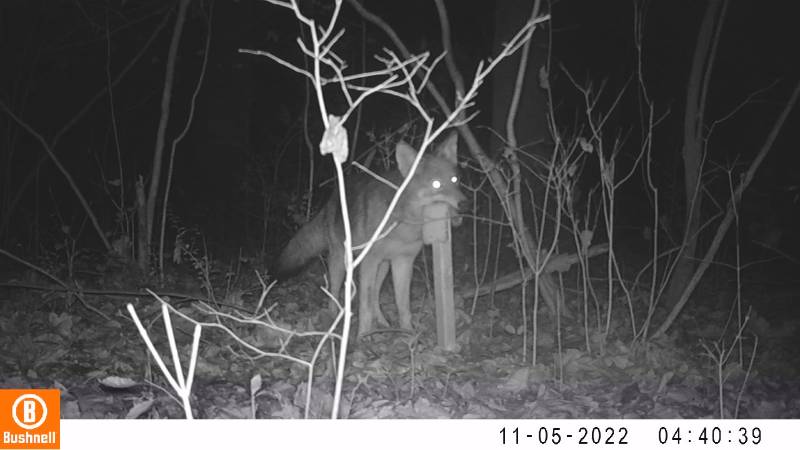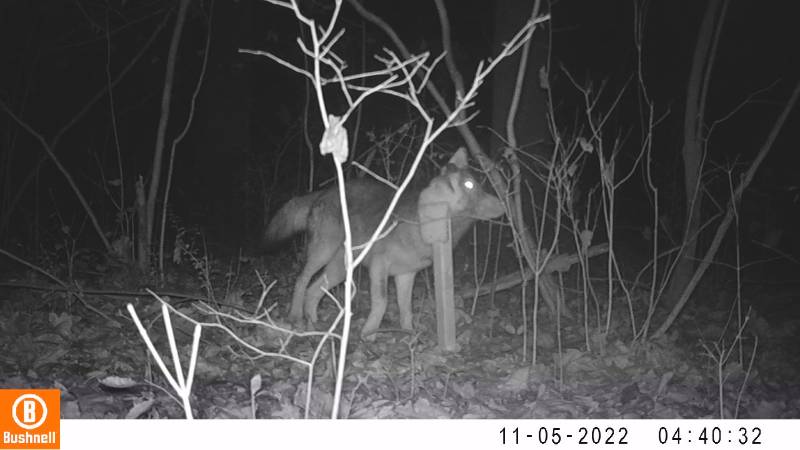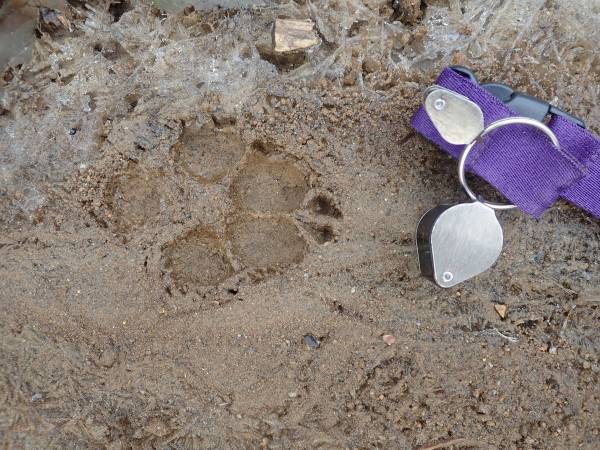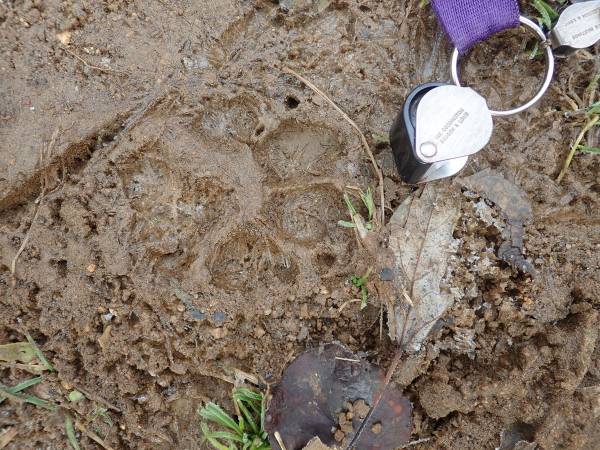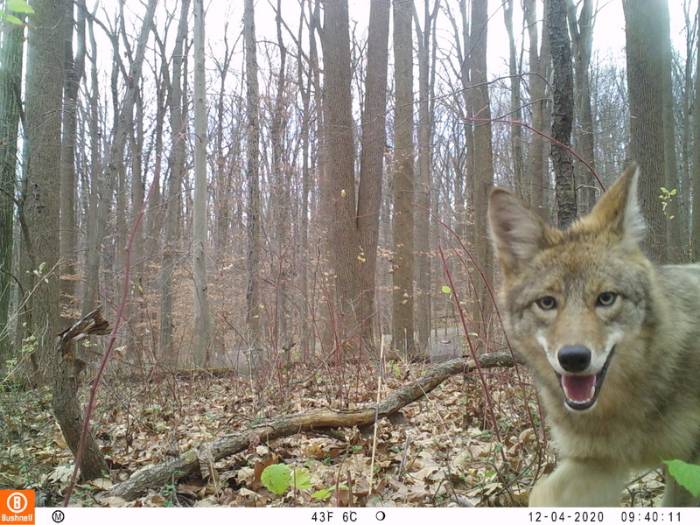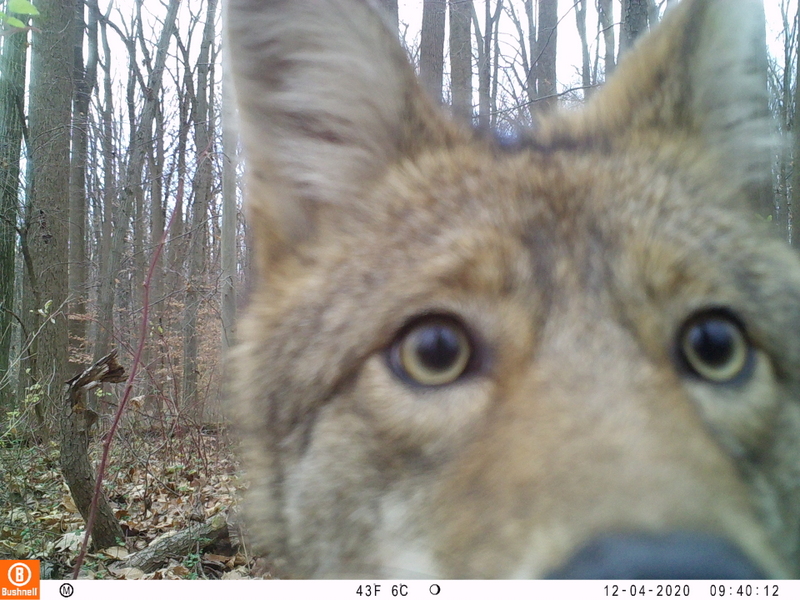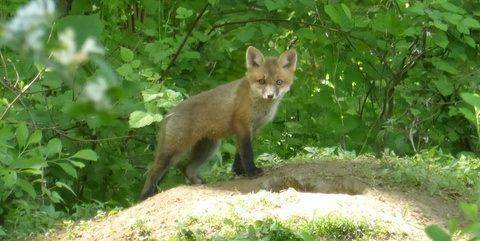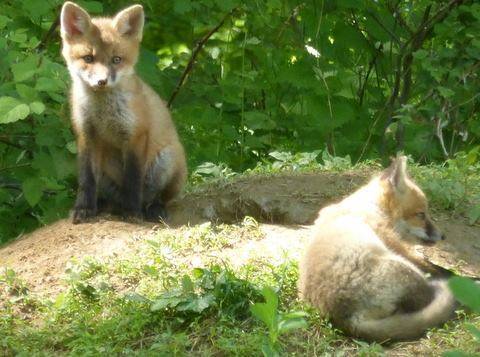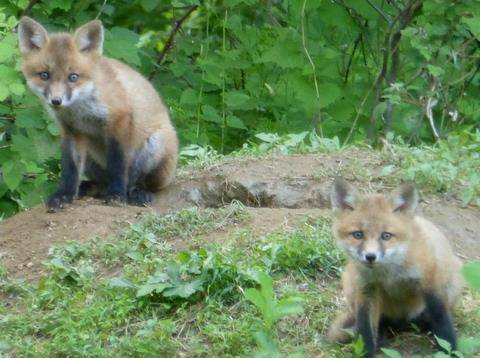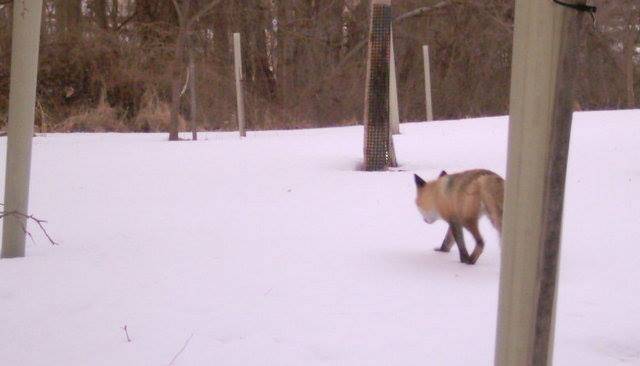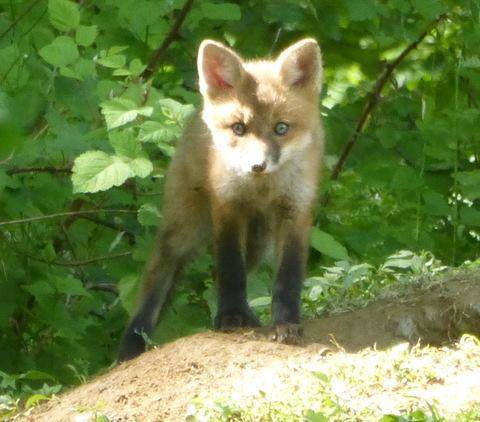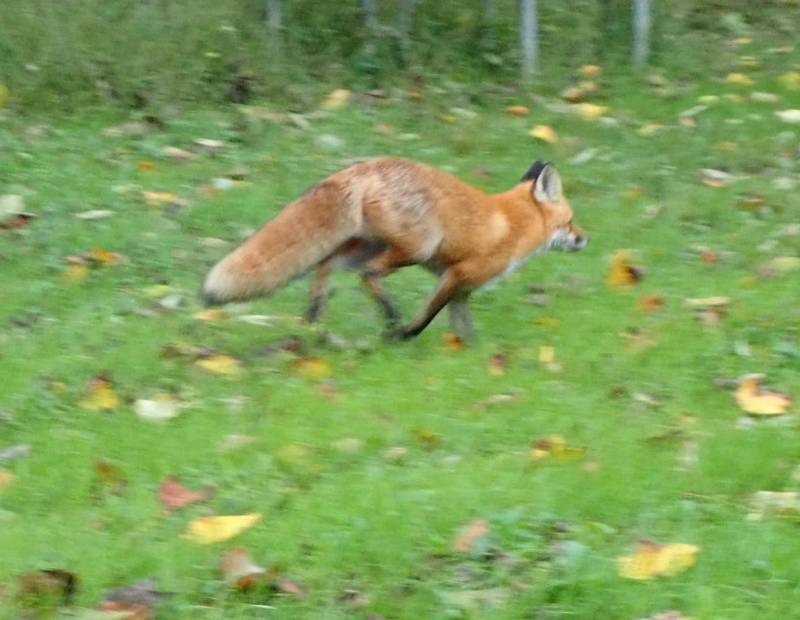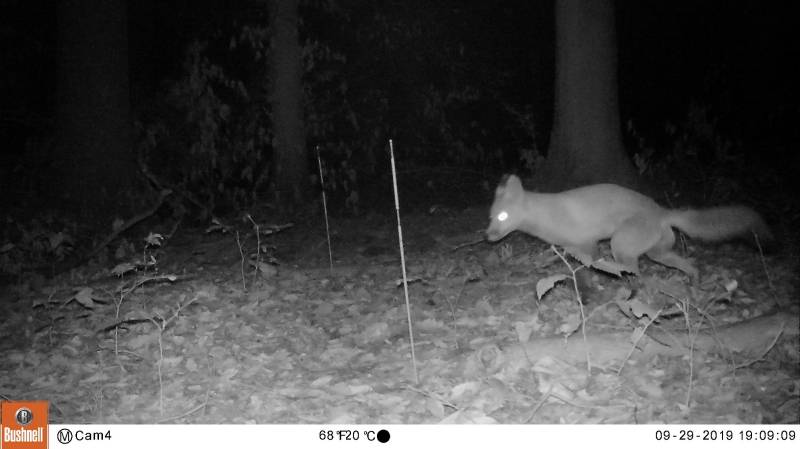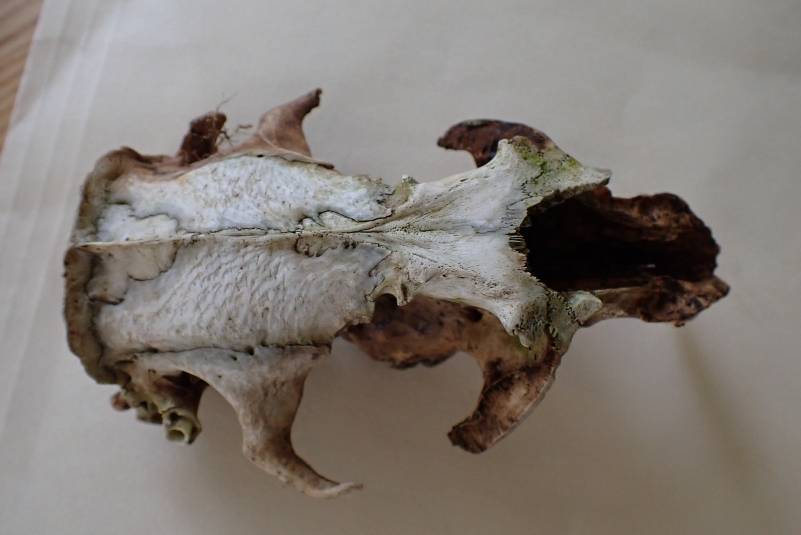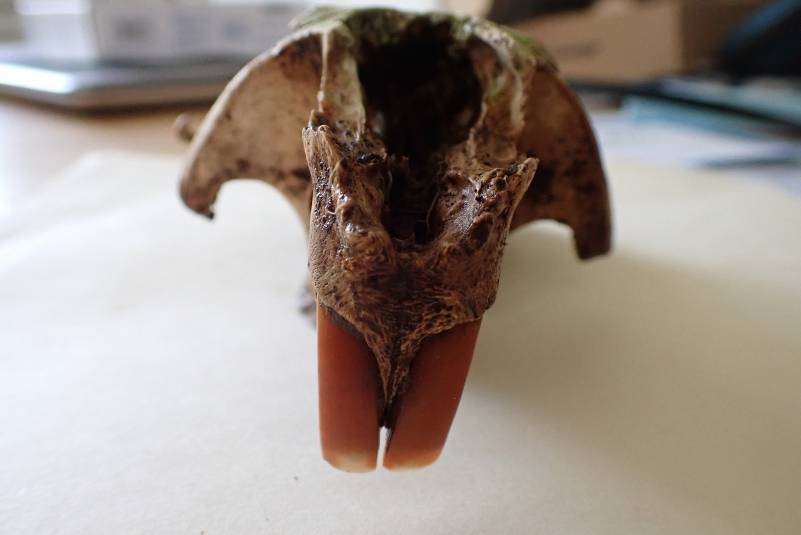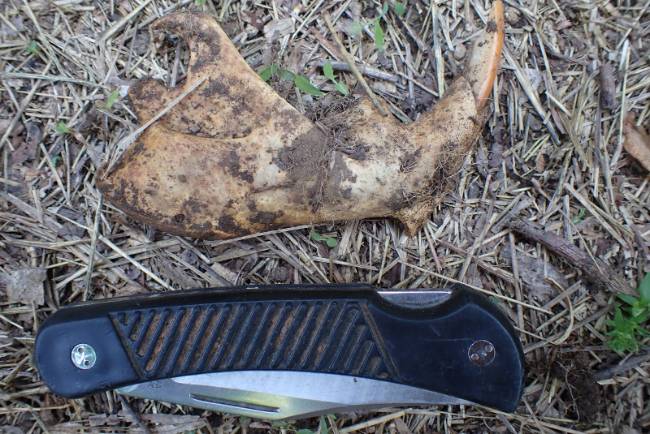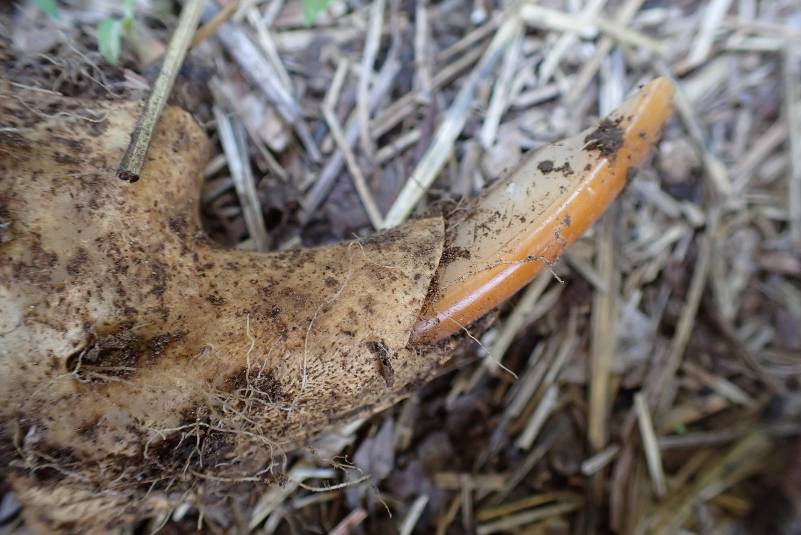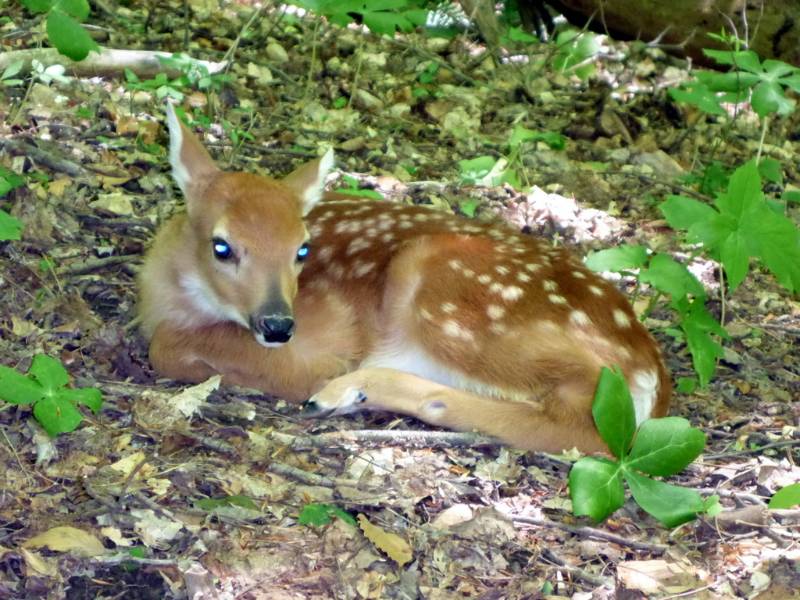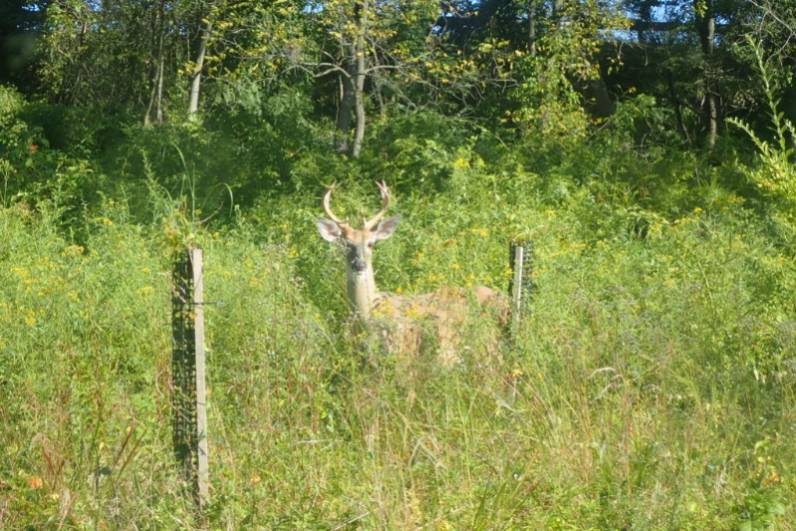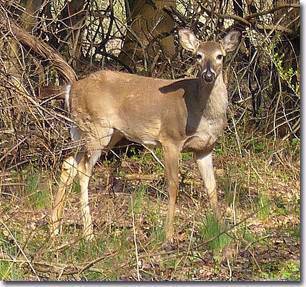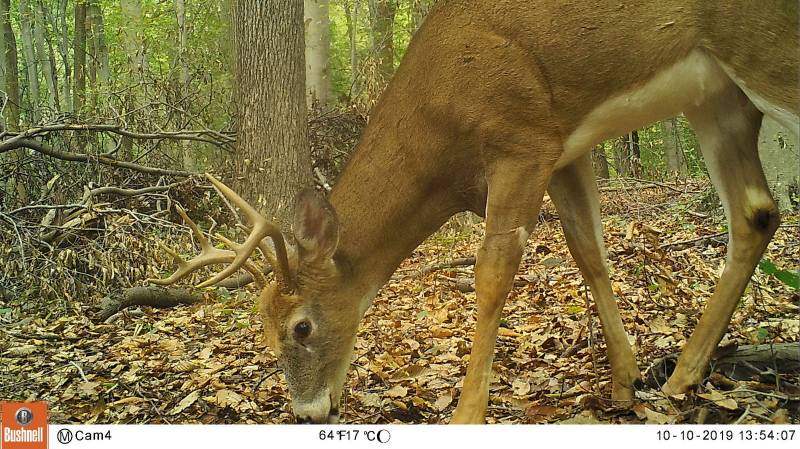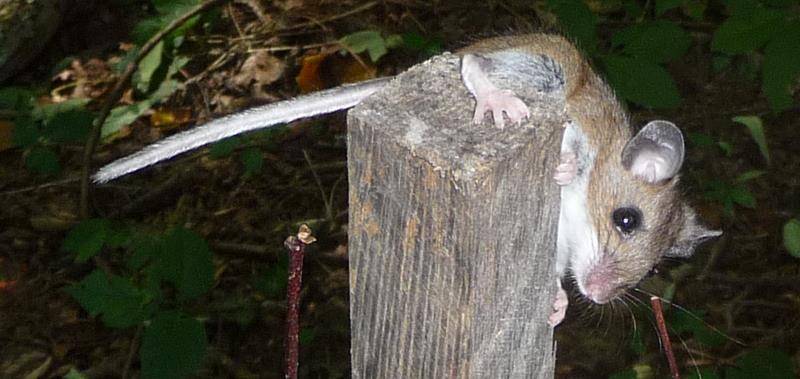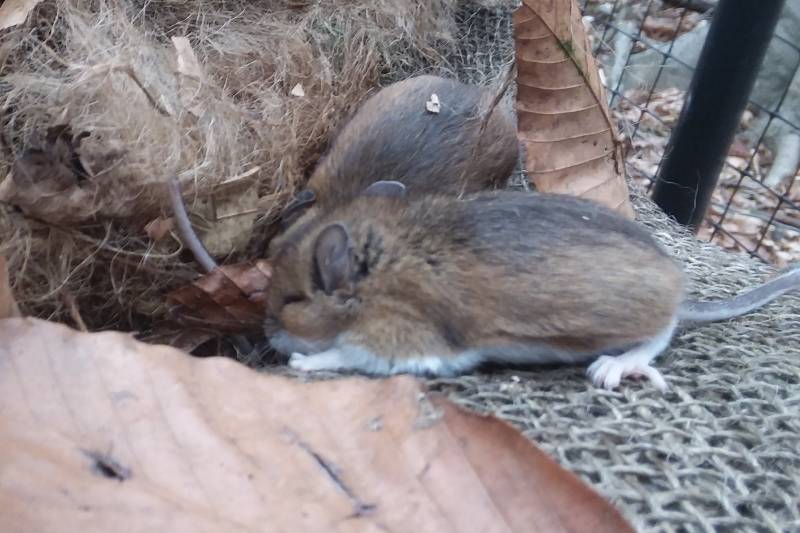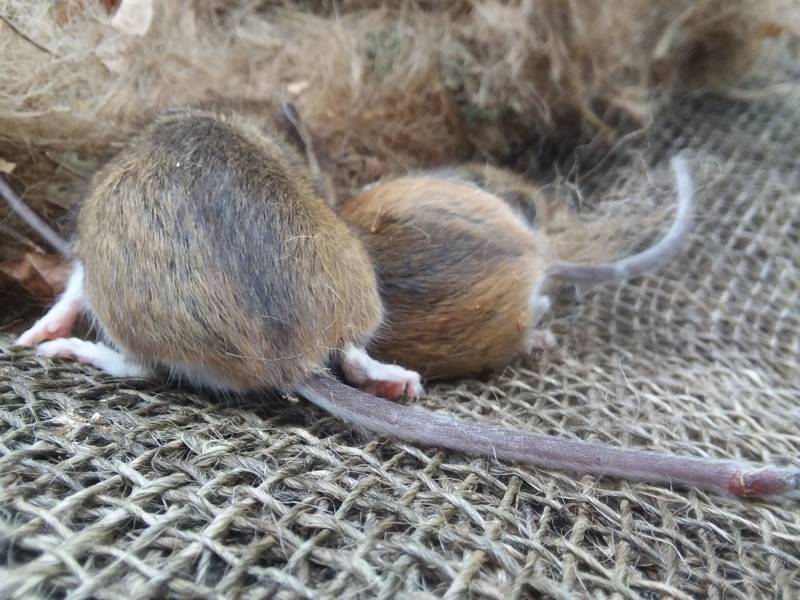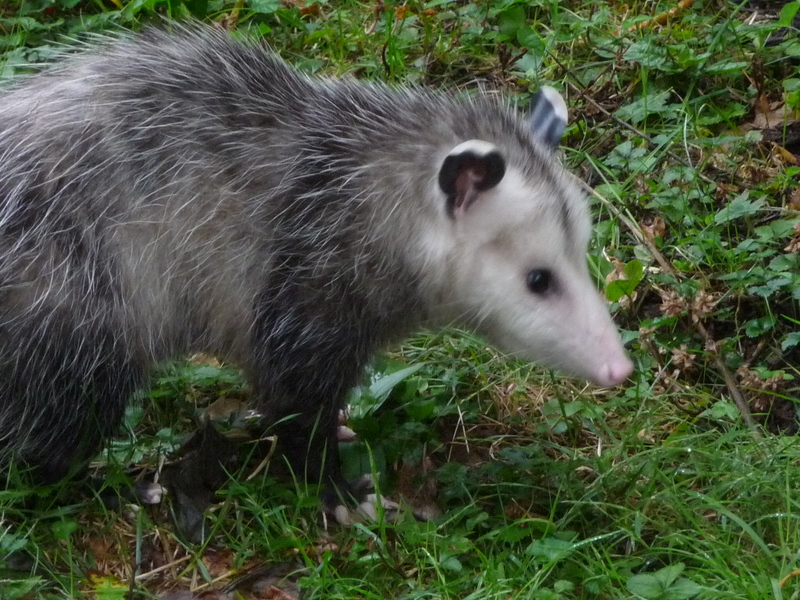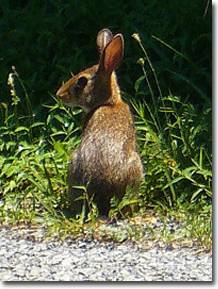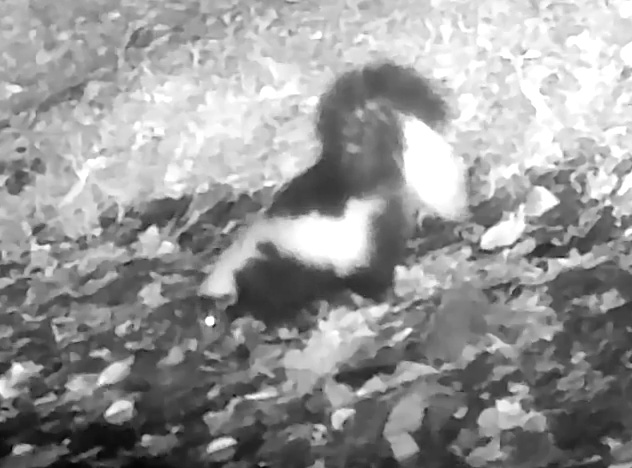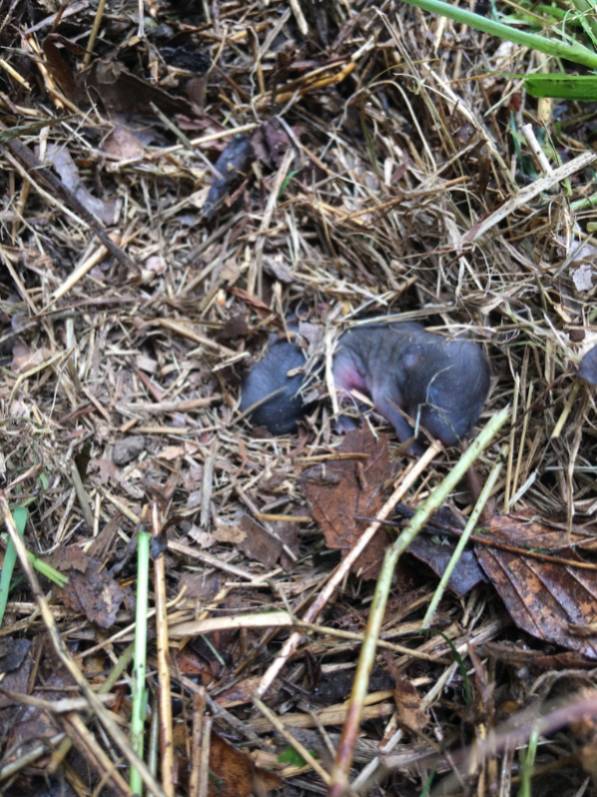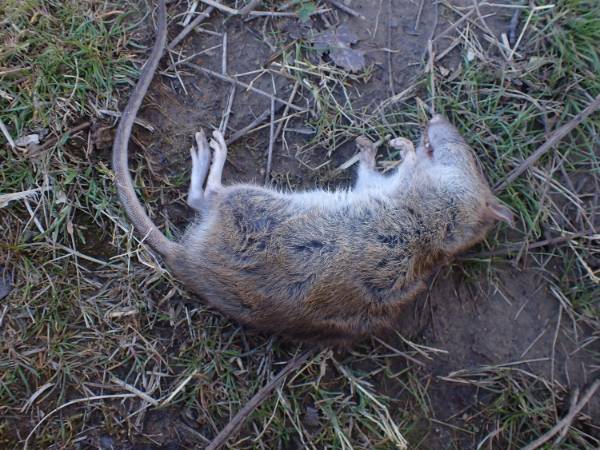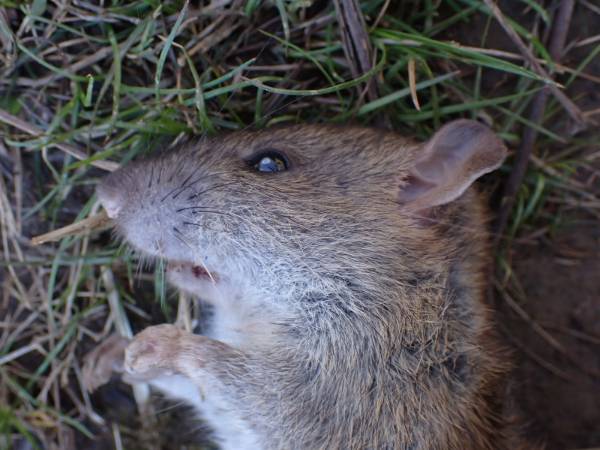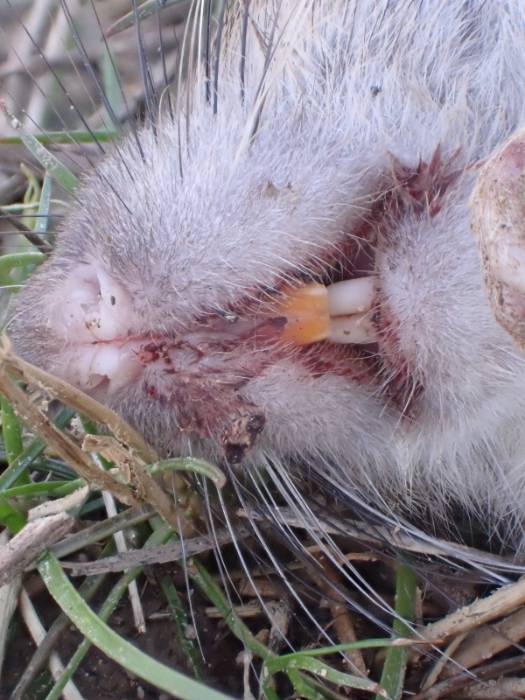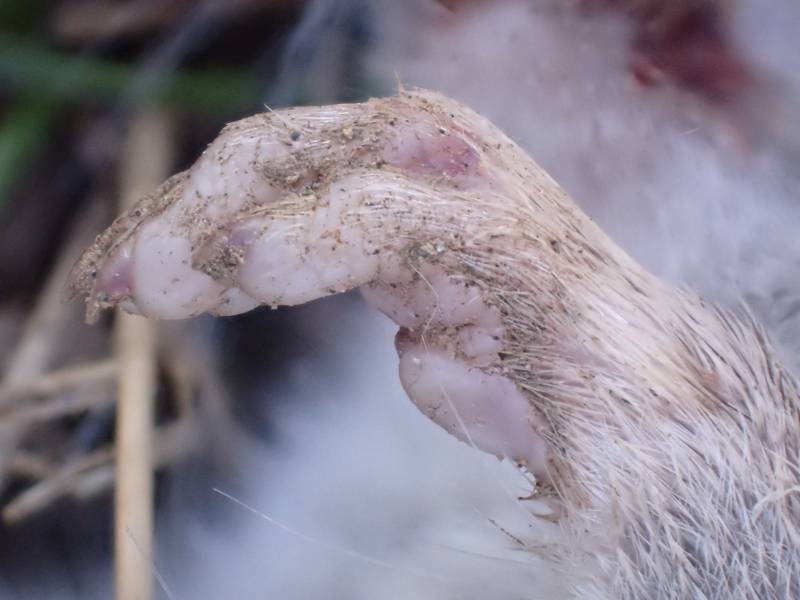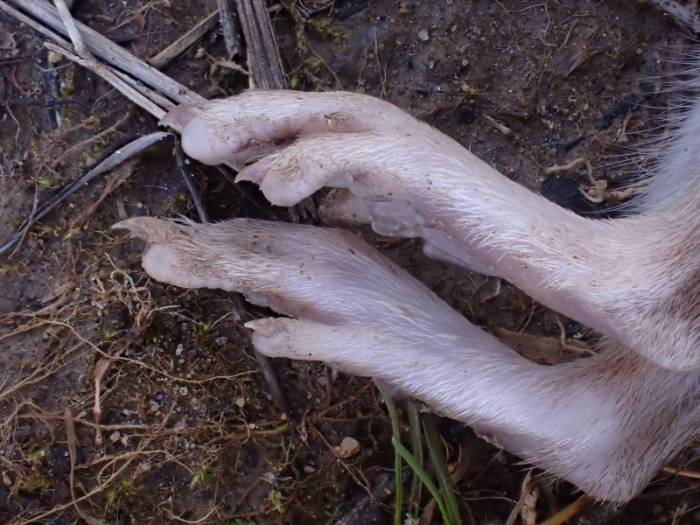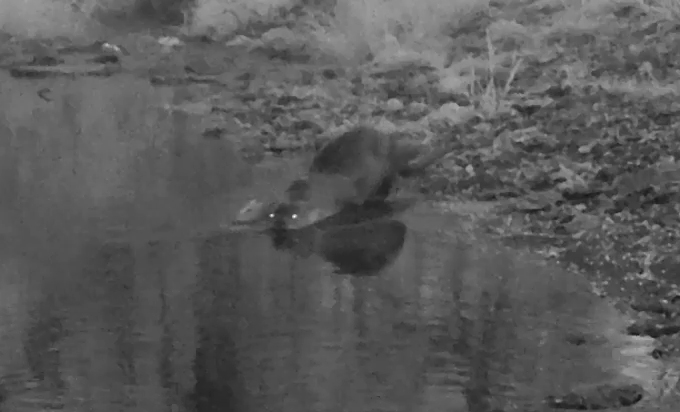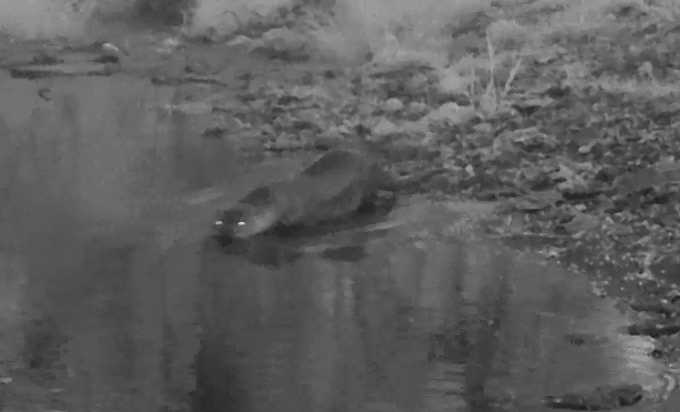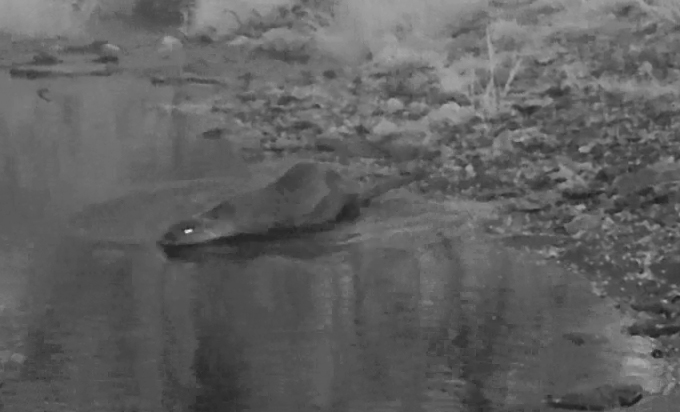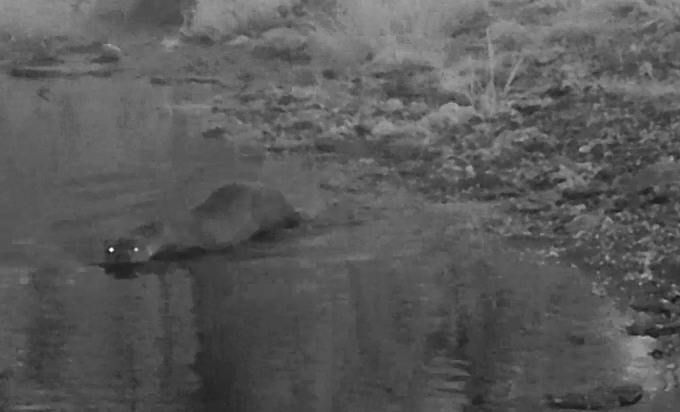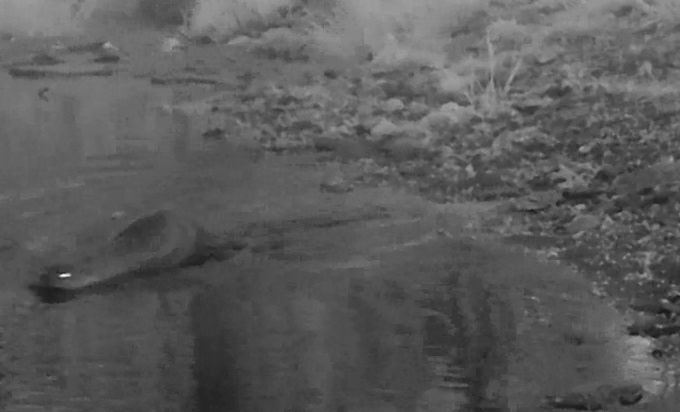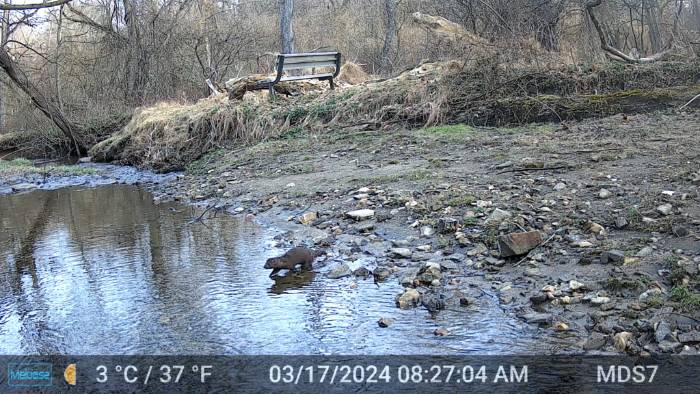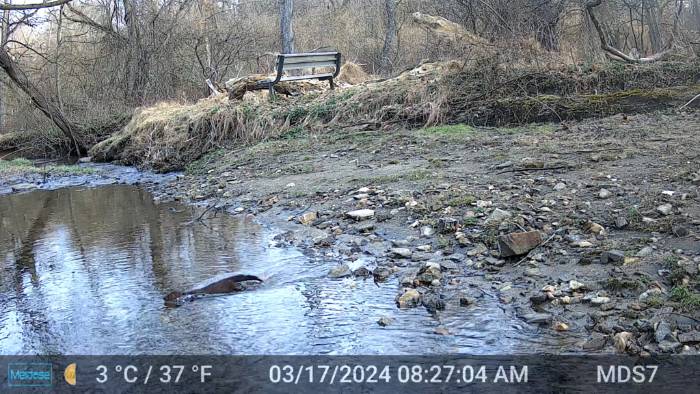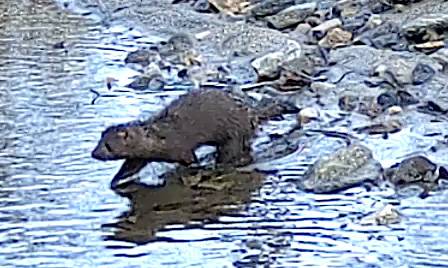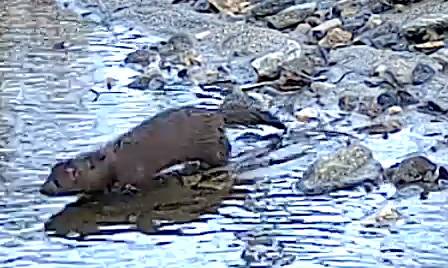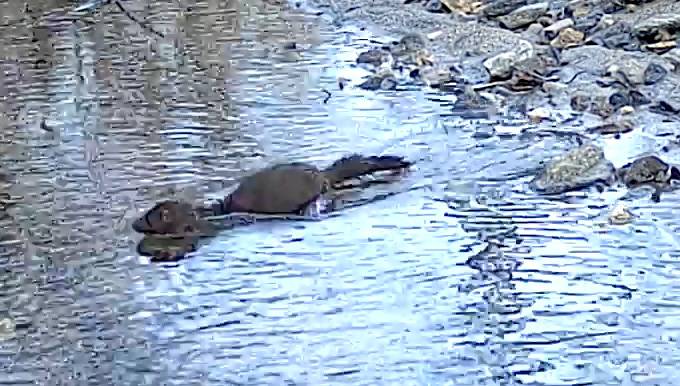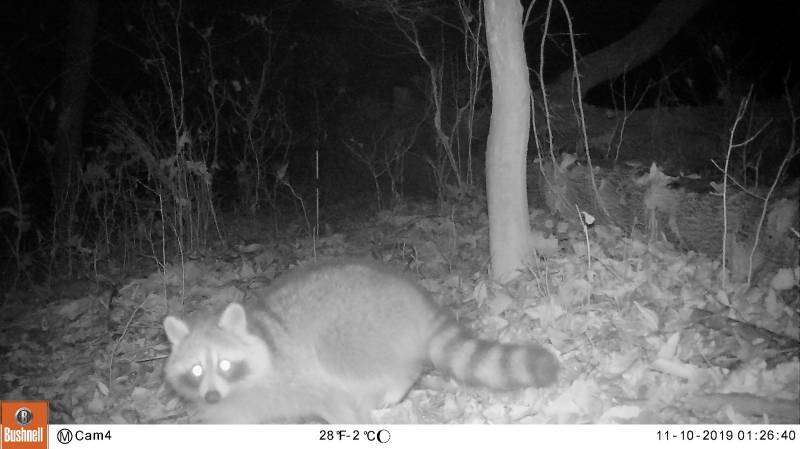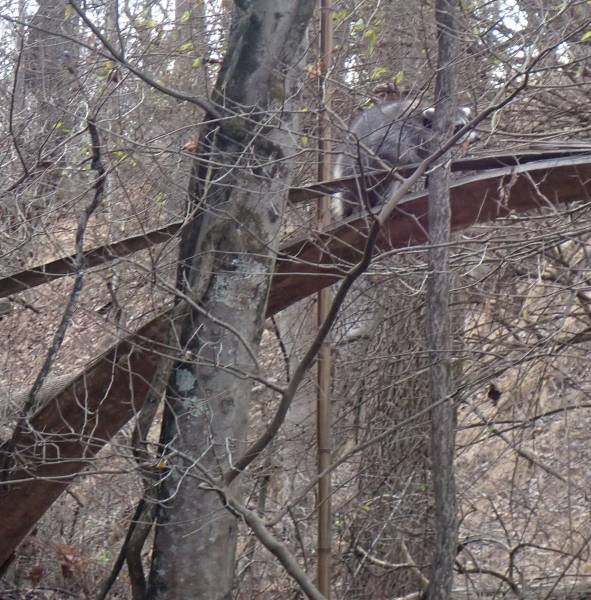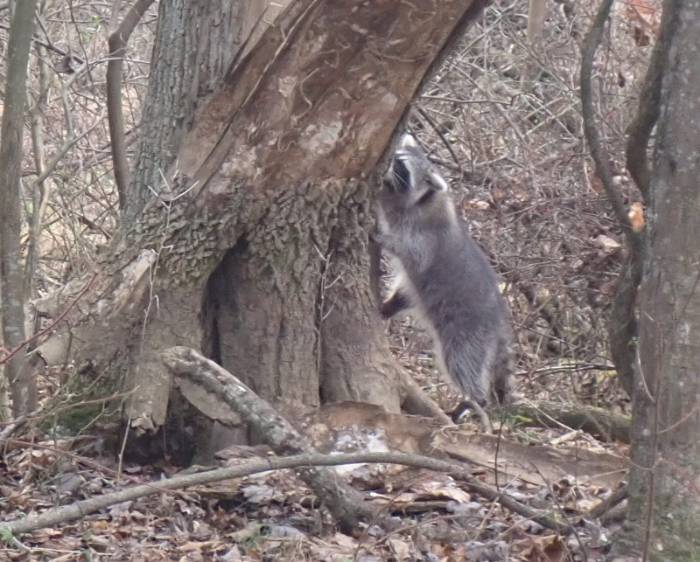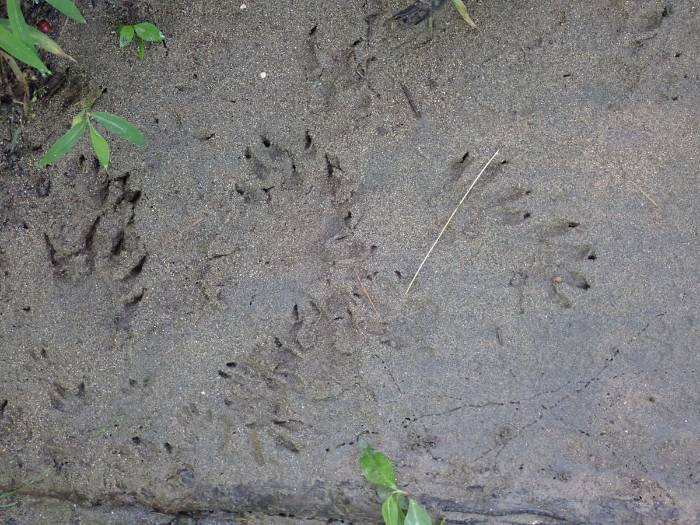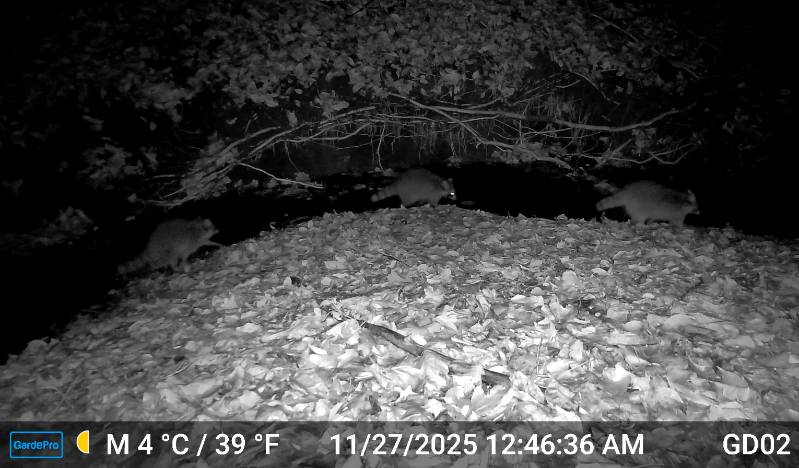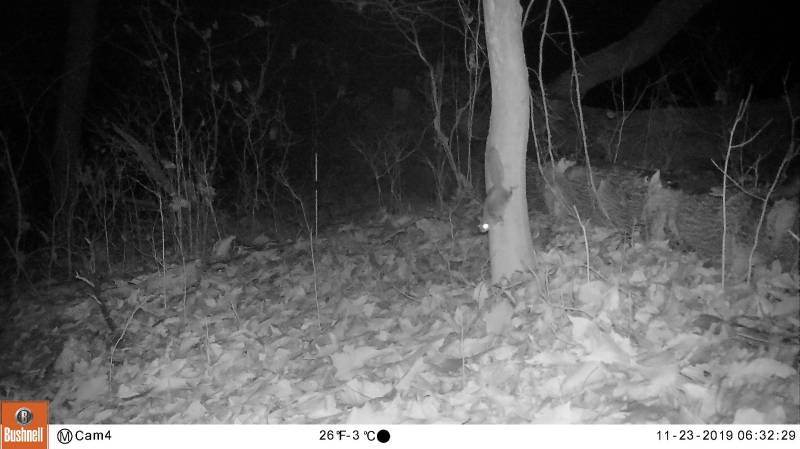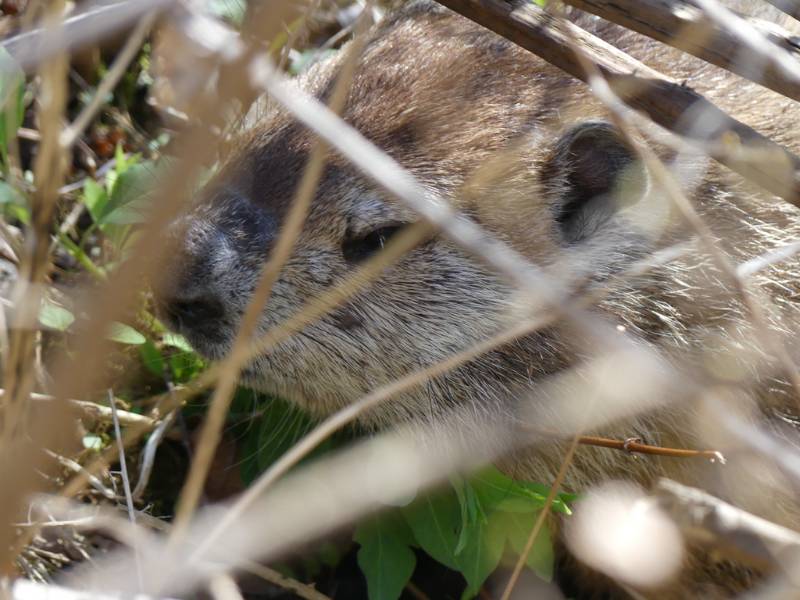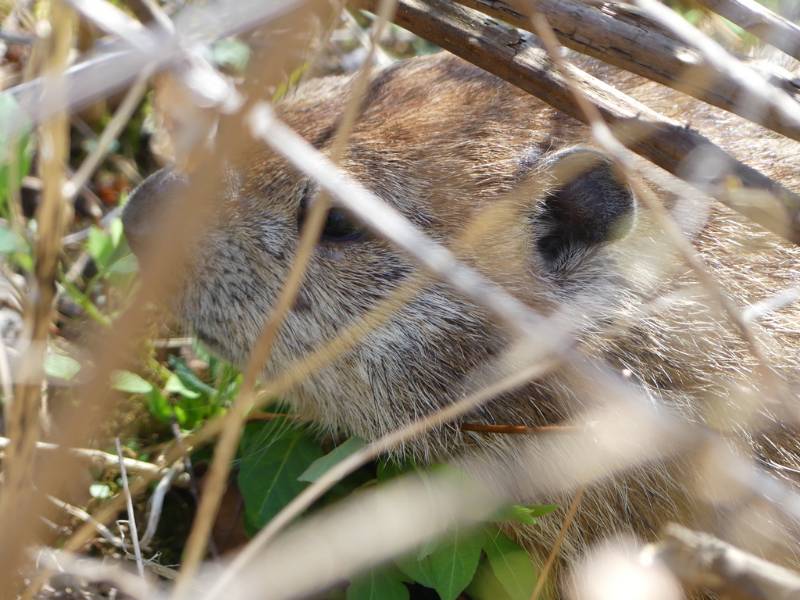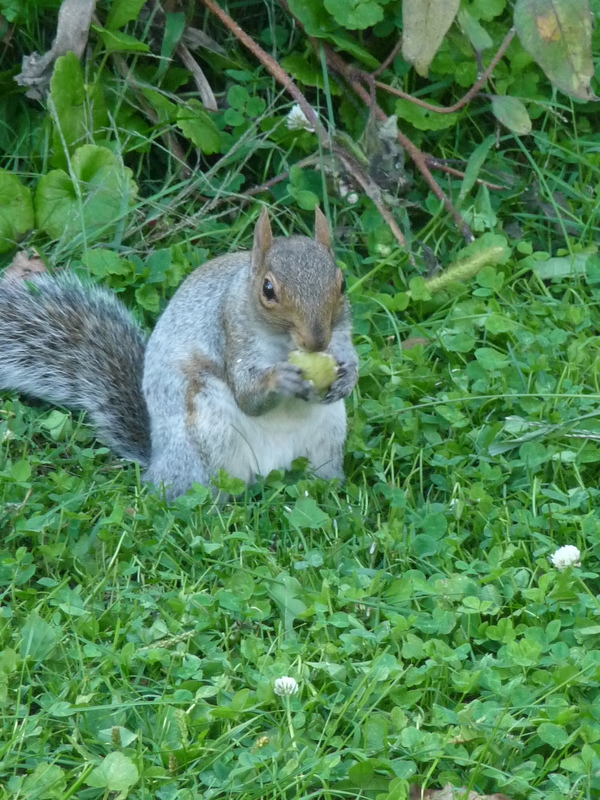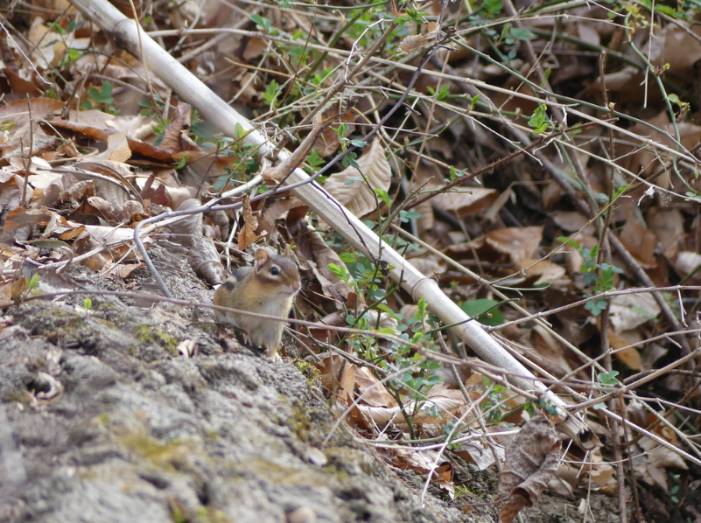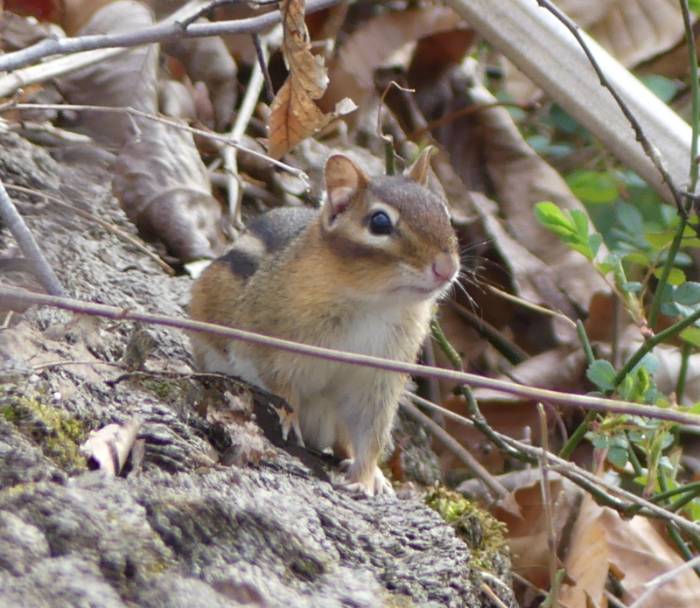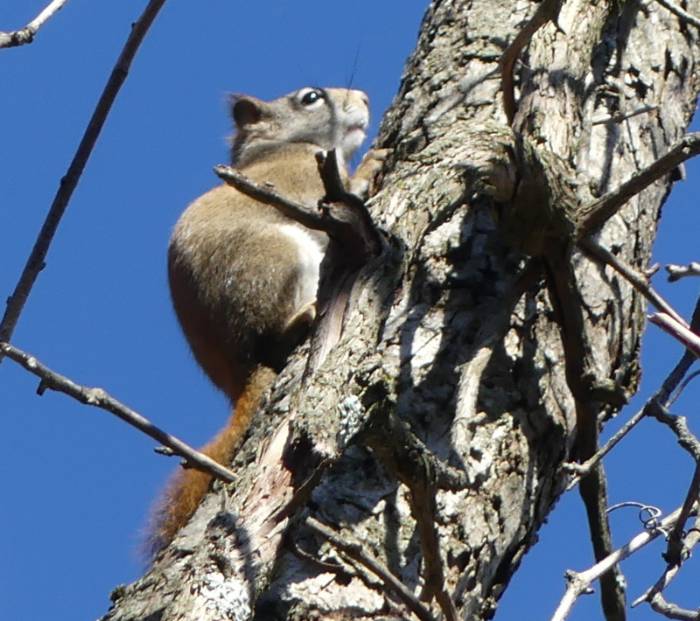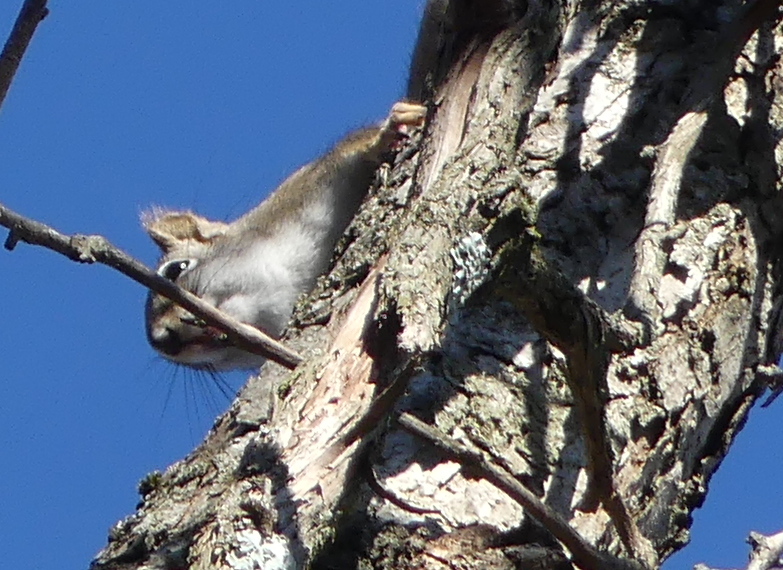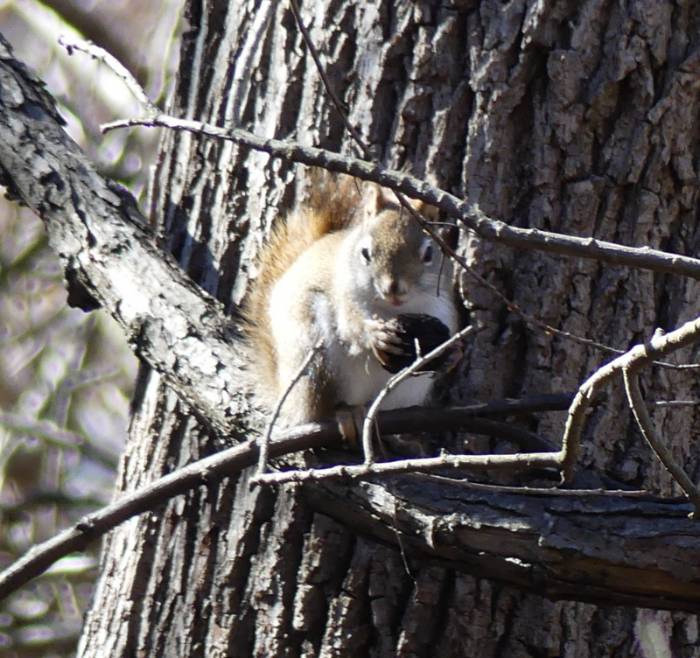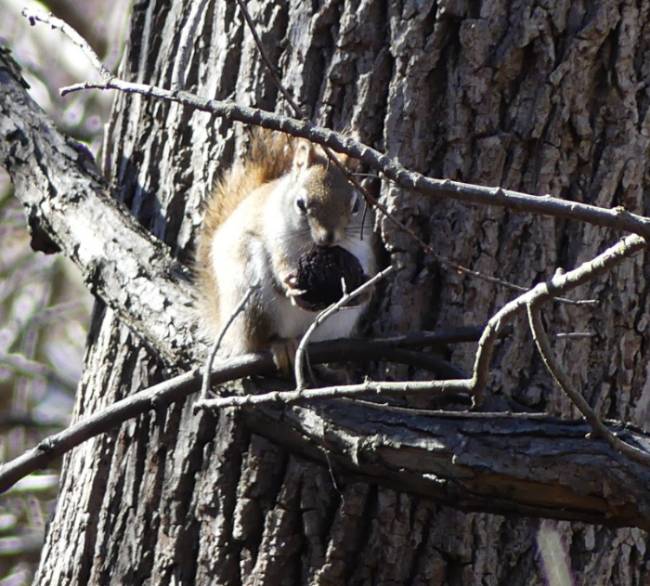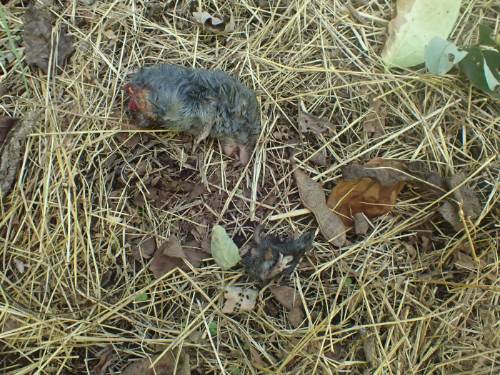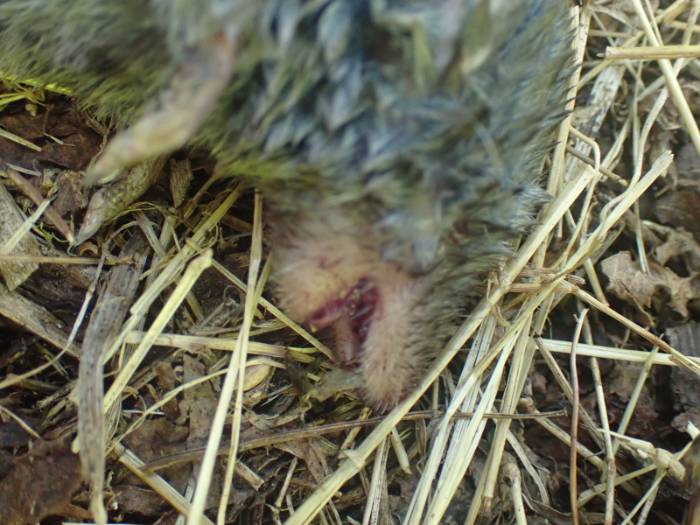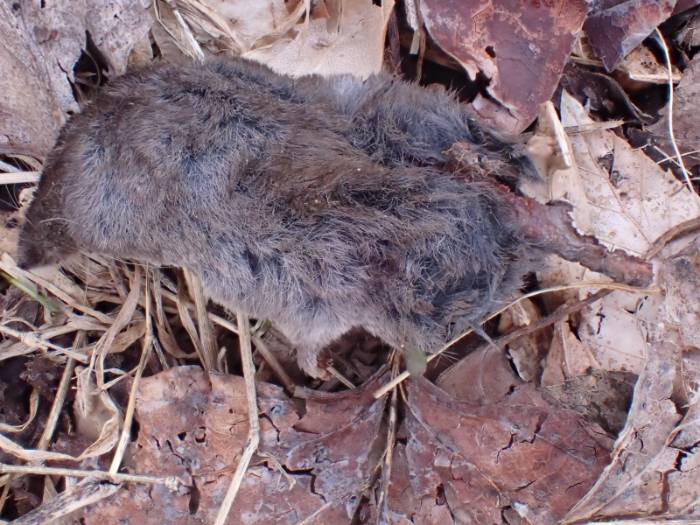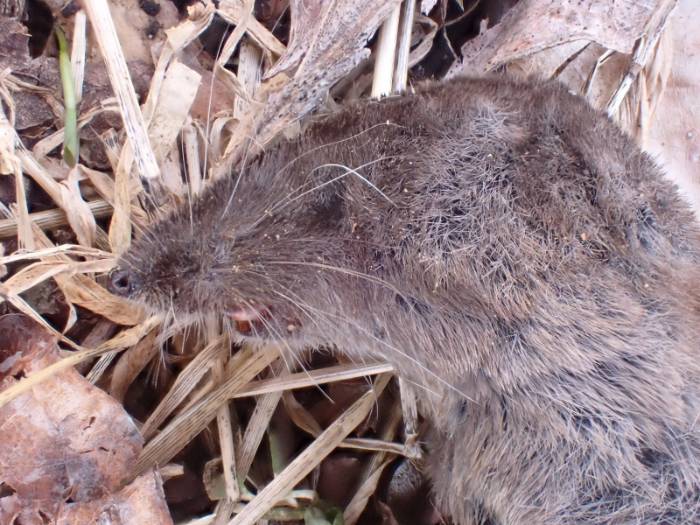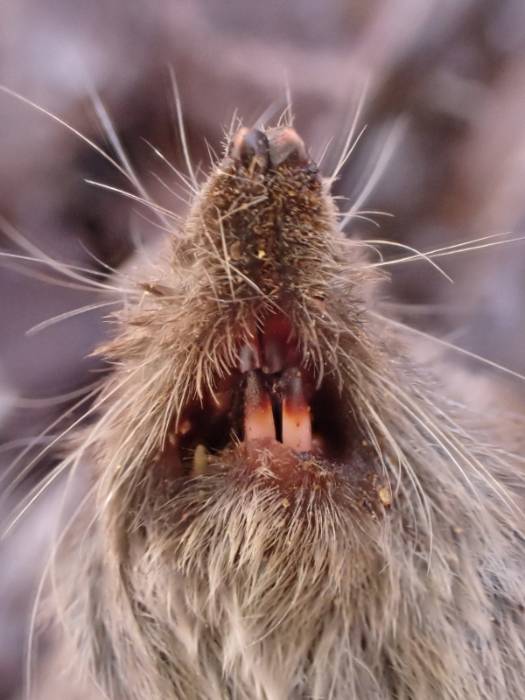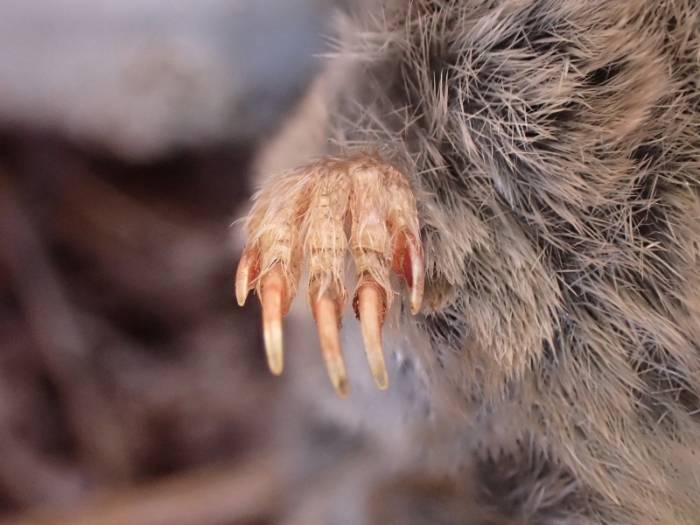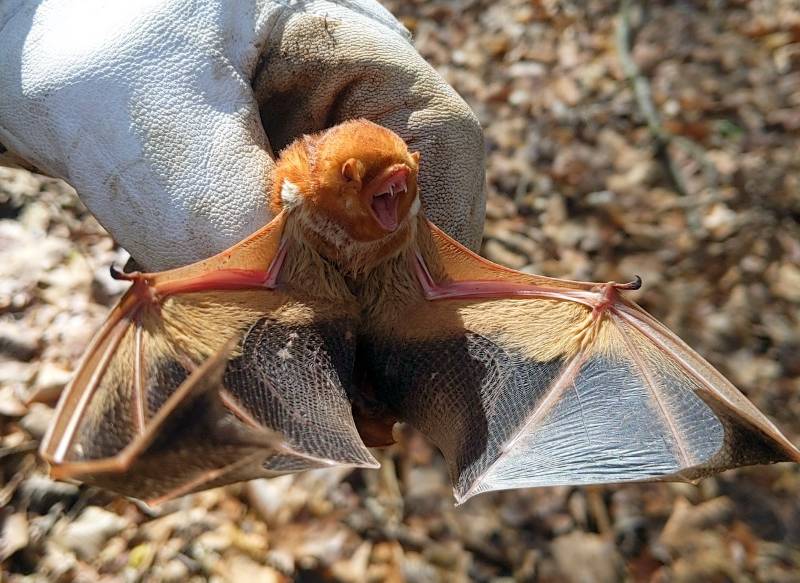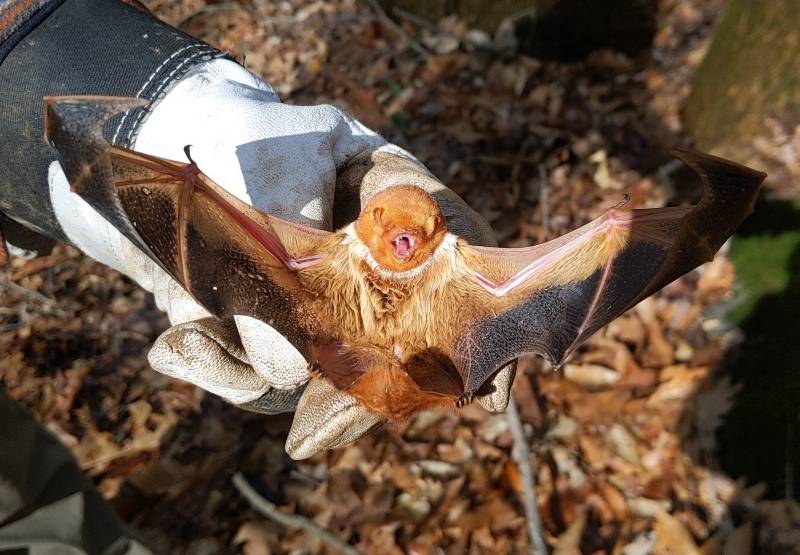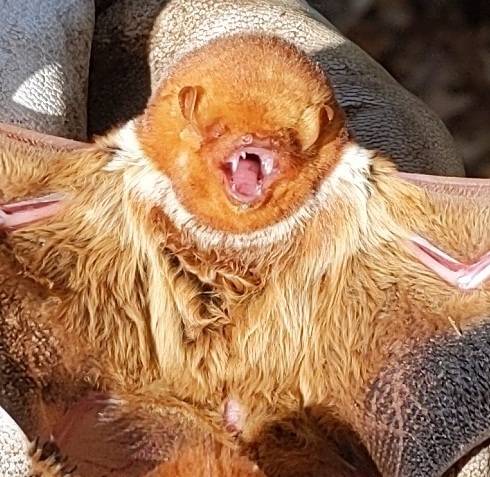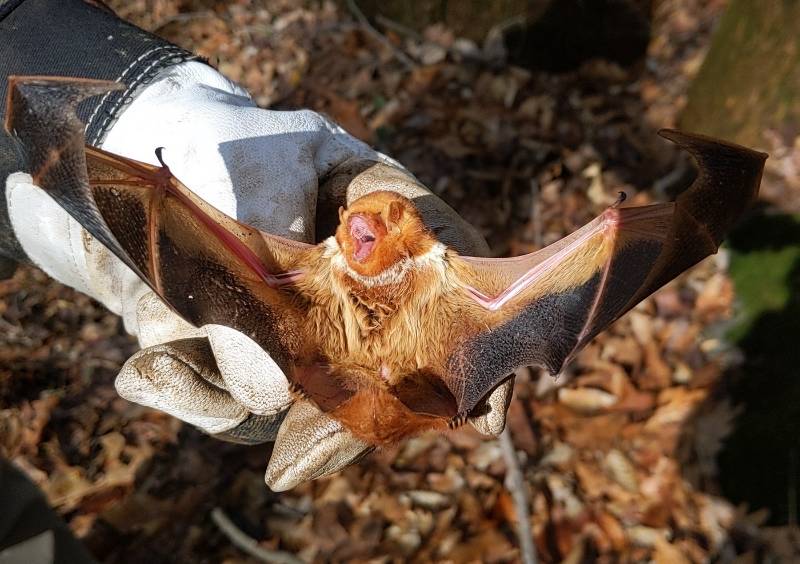The Biota of the Gordon Natural Area - Mammals
Until recently, mammal ‘research’ at the Gordon consisted of a checklist of mammal observations and trail camera images that was compiled by GNA staff. Despite this absence of focused research, the White-tailed Deer is one of the most commonly encountered animals at the GNA (perhaps second only to deer ticks) and deer have had profound effects on the flora of the GNA (primarily through overgrazing and selective grazing).
Beginning in 2019, Temple University Doctoral candidate Payton Phillips has included the Gordon as a study site in her investigation of wildlife and tick-borne diseases. Through this work, she has added one new mammal species, the Southern Flying Squirrel (Glaucomys volans ) to the GNA checklist and has also provided photographic confirmation of other mammals that we only ‘knew’ from their tracks (e.g., Raccoons) and/or from the leavings of prey that they had killed (e.g., from deer carcasses left by Coyotes).
To date, 14 species of mammals, in 13 Genera, 9 Families, and 5 Orders, have been noted at the GNA. It is worth noting that many of these species are ‘subsidized predators’: i.e., species (predators and scavengers) with broad-based diets whose population density is elevated by human-facilitated resources (e.g., garbage, etc.). These elevated populations then can potentially ‘spill over’ into adjacent, non-developed areas (in this case, the Gordon), thereby exerting undo pressure on the ecosystem.
You can explore the mammal checklist below, or you can access a pdf copy of the checklist.
Canis latrans (Coyote)
Group: Mammals
Family: Canidae
Notes
Common Names: Coyote
Years Observed: 2020; 2022; 2023; 2024
Identified By: Payton Phillips
First Noted By: Wildlife Camera
Also Noted By: Anna Carlson; Nur Ritter (tracks)
Notes:
For a number of years, we suspected that Coyotes were present in the Gordon because we repeatedly found the remains of dead fawns that had been dismembered and carried far from the killing site. Finally, in 2020, Temple University Doctoral student Payton Phillips came up with a verified Coyote sighting from one of her trail cameras. Then, in 2022, Temple U. Masters' student Anna Carlson came up with a trail cam photo of a second Coyote. Since, that time, GNA Staff have come across two sets of Coyote tracks and GNA trail cameras have recorded videos of coyotes in various parts of the GNA.
iNaturalist Observations:
148690747 (Observed: 2/2/2023)
147479252 (Observed: 1/27/2023)
GNA YouTube Videos featuring the Coyote:
Coyotes kill doe (and the week that follows) (Video Posted: 3/29/2024)
Trailcam: Geologists meet Coyote (Video Posted: 02/13/2024)
Coyote in the Gordon woods at night (Video Posted: 05/12/2023)
Coyotes kill doe (and the week that follows) (Video Posted: 2/29/2024)
Images
Vulpes vulpes (Red Fox)
Group: Mammals
Family: Canidae
Notes
Common Names: Red Fox
Years Observed: 2008; 2010; 2016; 2017; 2018; 2019; 2020; 2021; 2022; 2023; 2024
Identified and First Noted By: Gerry Hertel
Also Noted By: Kendra McMillin; Nur Ritter; Maribeth Beatty; Ariana Rivellini; Payton Phillips; Kathryn Krueger; Miranda Davies; Wildlife Camera(s)
Notes:
Often seen at the Gordon, and there have been various years when kits have been observed. Food sources in surrounding properties allow for a greater than normal number of Red Foxes in the GNA.
iNaturalist Observations:
150728759 (Observed: 3/8/2023)
149426876 (Observed: 2/22/2023)
148691409 (Observed: 2/3/2023)
147284352 (Observed: 1/11/2023)
GNA YouTube Videos featuring the Red Fox:
Coyotes kill doe (and the week that follows) (Video Posted: 3/29/2024)
Trailcam: Fox vs. Heron II 🦊 (Video Posted: 02/20/2024)
Red Fox ponders eating a Great Blue Heron (Video Posted: 11/03/2023)
Fox Leaping at night in the rain (Video Posted: 09/18/2023)
What Does The Fox Say? — Fox calling alongside Plum Run. (Video Posted: 06/27/2023)
Red Fox kit being homeschooled (Video Posted: 06/11/2023)
Two Red Fox kits exploring around their den at night. (Video Posted: 06/06/2023)
Red Fox surveying along the Cattail Swamp (Video Posted: 05/01/2023)
Red Fox crossing Plum Run (Video Posted: 03/08/2023)
Images
Castor canadensis (American Beaver)
Group: Mammals
Family: Castoridae
Notes
Common Names: American Beaver
Year Observed: 2022
Identified By: Thomas W. French (iNaturalist)
First Noted By: N. Ritter
Notes:
To date, known for the Gordon only from a skull that was found near to the Route 202 ramp in the spring of 2022 during the construction of a new trail. Our guess is that this individual may have traveled from Brandywine Creek (where there are known populations of American Beavers), up Plum Run, and onto Gordon Run. It would have encountered the Route 202 ramp at the upper end of Gordon Run and may have either been hit by a vehicle or just expired in the Gordon. Alternatively, the skull may have been dropped over the Gordon by a raptor (no bones other than the skull were found), or died elsewhere in the Gordon or surrounding area and was carried to where it was found by a scavenger.
iNaturalist Observations:
118550595 (Observed: 5/24/2022)
Images
Odocoileus virginianus (White-tailed Deer)
Group: Mammals
Family: Cervidae
Notes
Common Names: White-tailed Deer
Years Observed: 2007; 2008; 2009; 2010; 2011; 2012; 2013; 2014; 2015; 2016; 2017; 2018; 2019; 2020; 2021; 2022; 2023; 2024
Identified and First Noted By: William Overlease
Also Noted By: Gerry Hertel; Harry Tiebout; Jessica Schedlbauer; Greg Turner; Kendra McMillin; Nur Ritter; Alexandra Hodowanec; Kate Thompson; Paige Vermeulen; Maribeth Beatty; Jared Kline; Ariana Rivellini; Noah Long; Payton Phillips; Maeve Dowd; Maddison Rettenmaier; Kathryn Krueger; Miranda Davies; Alex Desjardines; Jessica Greulich; James Simpson (and, undoubtedly, many others); Wildlife Camera(s)
Notes:
The GNA is inhabited by a white-tailed deer population that is approximately 4-8 times its carrying capacity. This high population results in significant over-browsing and appears to be driving a transition in the GNA towards plant species that are resistant to browsing.
iNaturalist Observations:
137661784 (Observed: 10/5/2022)
83943509 (Observed: 6/21/2021)
70339958 (Observed: 2/28/2021)
GNA YouTube Videos featuring the White-tailed Deer:
Coyotes kill doe (and the week that follows) (Video Posted: 3/29/2024)
Deer Browsing Fungi #trailcam #deer (Video Posted: 03/05/2024)
Deer vs Tree Cage #shorts (Video Posted: 02/12/2024)
Deer in a bamboo grove at the GNA (Video Posted: 07/18/2023)
Some Wild and Crazy Deer (Video Posted: 05/12/2023)
Images
Peromyscus leucopus (White-footed Mouse)
Group: Mammals
Family: Cricetidae
Notes
Common Names: White-footed Mouse
Years Observed: 2011; 2021; 2023
Identified and First Noted By: Gerry Hertel
Also Noted By: Nur Ritter; Miranda Davies; Wildlife Camera(s)
Notes:
A primary carrier of Lyme Disease bacteria.
iNaturalist Observations:
68608187 (Observed: 1/25/2021)
Images
Didelphis virginiana (Opossum)
Felis catus (Feral Cat)
Group: Mammals
Family: Felidae
Notes
Common Names: Feral Cat
Year Observed: 2023
Identified By: Nur Ritter
First Noted By: Wildlife Camera
Sylvilagus floridanus (Eastern Cottontail)
Group: Mammals
Family: Leporidae
Notes
Common Names: Eastern Cottontail
Years Observed: 2016; 2017; 2018; 2019; 2020; 2021; 2022; 2023; 2024
Identified and First Noted By: Kendra McMillin
Also Noted By: Gerry Hertel; Nur Ritter; Paige Vermeulen; Maribeth Beatty; Noah Long; Miranda Davies; Kathryn Krueger; David Kramer; Wildlife Camera(s)
Images
Mephitis mephitis (Striped Skunk)
Group: Mammals
Family: Mephitidae
Notes
Common Names: Striped Skunk
Years Observed: 2019; 2021; 2023; 2024
Identified By: Nur Ritter
First Noted By: Nur Ritter (by scent)
Also Noted By: Wildlife Camera
Notes:
For many years, the presence of Striped Skunks in the Gordon was based on its scent. However, in 2023 we began seeing this species on trail camera images.
iNaturalist Observations:
186087593 (Observed: 10/2/2023)
Images
Rattus norvegicus (Brown Rat)
Group: Mammals
Family: Muridae
Notes
Common Names: Brown Rat
Years Observed: 2018; 2023; 2024
Identified and First Noted By: Jared Kline
Also Noted By: Miranda Davies; Nur Ritter; Wildlife Camera
iNaturalist Observations from the GNA:
169829414 (Observed: 6/20/2023)
Images
Lontra canadensis (North American River Otter)
Group: Mammals
Family: Mustelidae
Notes
Common Names: North American River Otter
Year Observed: 2024
Identified By: Nur Ritter
First Noted By: Wildlife Camera
iNaturalist Observations from the GNA:
209302055 (Observed: 4/23/2024)
GNA YouTube Videos featuring the North American River Otter:
Otter in the GNA (Video Posted: 4/25/2024)
Images
Neogale vison (American Mink)
Group: Mammals
Family: Mustelidae
Notes
Common Names: American Mink
Years Observed: 2022; 2024
Identified and First Noted By: David Kramer
Also Noted By: Wildlife Camera; Kevin Murtaugh
Notes:
Kevin Murtaugh—a long-time visitor to the Gordon—reported having seen a mink in the meadow in the eastern GNA in 2024.
iNaturalist Observations from the GNA:
202441066 (Observed: 3/13/2024)
GNA YouTube Videos featuring the American Mink:
#trailcam Mink & Groundhog in the stream (Video Posted: 3/15/2024)
Minks and Groundhog in water (Video Posted: 3/28/2024)
Images
Procyon lotor (Raccoon)
Group: Mammals
Family: Procyonidae
Notes
Common Names: Raccoon
Years Observed: 2008; 2011; 2019-2020; 2022-2025
Identified and First Noted By: Kendra McMillin
Also Noted By: Payton Phillips; Nur Ritter; Kathryn Krueger (tracks); Wildlife Camera
iNaturalist Observations from the GNA:
60457549 (Observed: 9/22/2020)
272238547 (Observed: 4/23/2025)
194454494 (Observed: 12/20/2023)
148691089 (Observed: 2/3/2023)
148401882 (Observed: 2/9/2023)
147478068 (Observed: 1/27/2023)
110836027 (Observed: 4/8/2022)
GNA YouTube Videos featuring the Raccoon:
What if a tree falls in the forest and nobody's there to hear it (except a trail cam)? (Video Posted: 08/28/2023)
Raccoon Stampede!!! (Video Posted: 07/25/2023)
Raccoon Conga Line (Video Posted: 07/20/2023)
Raccoon having a drink (Video Posted: 05/19/2023)
Deers and raccoons near cherry tree (Video Posted: 2/29/2024)
Raccoon kits in tree (Video Posted: 11/2/2023)
Raccoon approaches Opossum (Video Posted: 10/12/2023)
Images
Glaucomys volans (Southern Flying Squirrel)
Group: Mammals
Family: Sciuridae
Notes
Common Names: Southern Flying Squirrel
Years Observed: 2019; 2023
Identified By: Payton Phillips
First Noted By: Wildlife Camera
Notes:
Noted during Tick-borne Disease monitoring by Peyton Phillips (Integrative Ecology Lab, Temple University, Philadelphia, PA).
iNaturalist Observations:
68926242 (Observed: 11/23/2019)
Images
Marmota monax (Groundhog)
Group: Mammals
Family: Sciuridae
Notes
Common Names: Groundhog
Years Observed: 2019; 2022; 2023; 2024
Identified and First Noted By: Nur Ritter
Also Noted By: Miranda Davies; Kathryn Krueger; Jessica Greulich; Wildlife Camera(s)
iNaturalist Observations:
149429630 (Observed: 2/22/2023)
112148362 (Observed: 4/14/2022)
GNA YouTube Videos featuring the Groundhog:
#trailcam Mink & Groundhog in the stream (Video Posted: 3/15/2024)
Groundhog Cliffhanger!!! (Video Posted: 08/21/2023)
Images
Sciurus carolinensis (Eastern Gray Squirrel)
Group: Mammals
Family: Sciuridae
Notes
Common Names: Eastern Gray Squirrel
Years Observed: 2008; 2010; 2016; 2017; 2018; 2019; 2020; 2021; 2022; 2023; 2024
Identified and First Noted By: Kendra McMillin
Also Noted By: Wildlife Camera(s); Gerry Hertel; Nur Ritter; Paige Vermeulen; Payton Phillips; Noah Long; Kathryn Krueger; Miranda Davies; and, countless others
iNaturalist Observations:
180020493 (Observed: 8/24/2023)
151061080 (Observed: 3/13/2023)
99625614 (Observed: 10/28/2021)
GNA YouTube Videos featuring the Eastern Gray Squirrel:
Discretion is the Better Part of Valor: Squirrel checks out Hawk (Video Posted: 10/18/2023)
What if a tree falls in the forest and nobody's there to hear it (except a trail cam)? (Video Posted: 08/28/2023)
Images
Tamias striatus (Eastern Chipmunk)
Group: Mammals
Family: Sciuridae
Notes
Common Names: Eastern Chipmunk
Years Observed: 2022; 2023
Identified and First Noted By: Kathryn Krueger
Also Noted By: Wildlife Camera(s)
Notes:
To date: A single individual has been noted.
iNaturalist Observations:
109239154 (Observed: 3/22/2022)
Images
Tamiasciurus hudsonicus (American Red Squirrel)
Group: Mammals
Family: Sciuridae
Notes
Common Names: American Red Squirrel
Years Observed: 2019; 2021; 2022; 2023; 2024
Identified and First Noted By: Nur Ritter
Also Noted By: Paige Vermeulen; Kathryn Krueger; Wildlife Camera(s)
iNaturalist Observations:
107418358 (Observed: 2/21/2022)
107417426 (Observed: 2/10/2022)
GNA YouTube Videos featuring the American Red Squirrel:
What if a tree falls in the forest and nobody's there to hear it (except a trail cam)? (Video Posted: 08/28/2023)
Images
Blarina brevicauda (Northern Short-tailed Shrew)
Group: Mammals
Family: Soricidae
Notes
Common Names: Northern Short-tailed Shrew
Year Observed: 2023
Identified By: Nur Ritter
First Noted By: Jessica Greulich
iNaturalist Observations from the GNA:
181090927 (Observed: 8/31/2023)
Images
Cryptotis parvus (North American Least Shrew)
Group: Mammals
Family: Soricidae
Notes
Common Names: North American Least Shrew
Year Observed: 2024
Identified and First Noted By: Nur Ritter
iNaturalist Observations from the GNA:
204412501 (Observed: 3/29/2024)
Images
Lasiurus borealis (Eastern Red Bat)
Group: Mammals
Family: Vespertilionidae
Notes
Common Names: Eastern Red Bat
Years Observed: 2022; 2025
Identified and First Noted By: Kathryn Krueger
Also Noted By: Jenny Uehling
Notes:
A distressed individual was on Kathryn Krueger's shoe in the large ginseng enclosure in Area G1S. No other individuals were noted.
iNaturalist Observations from the GNA:
112041716 (Observed: 4/19/2022)

